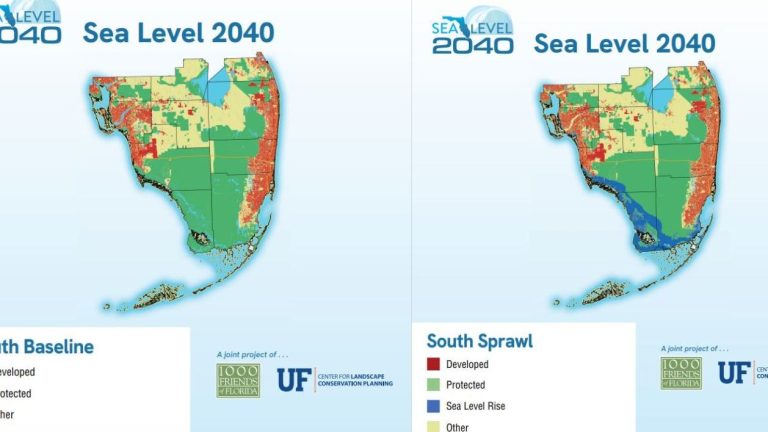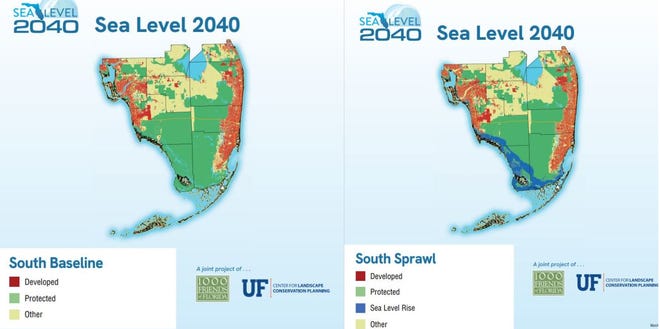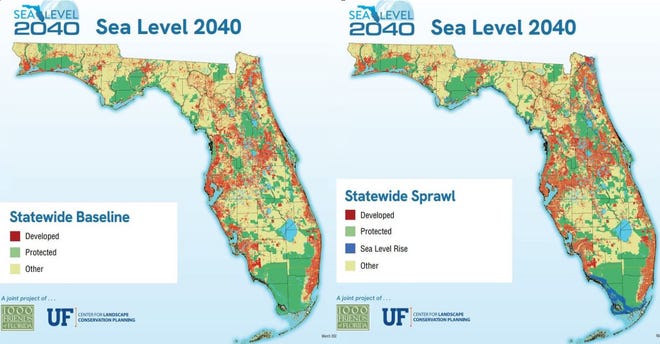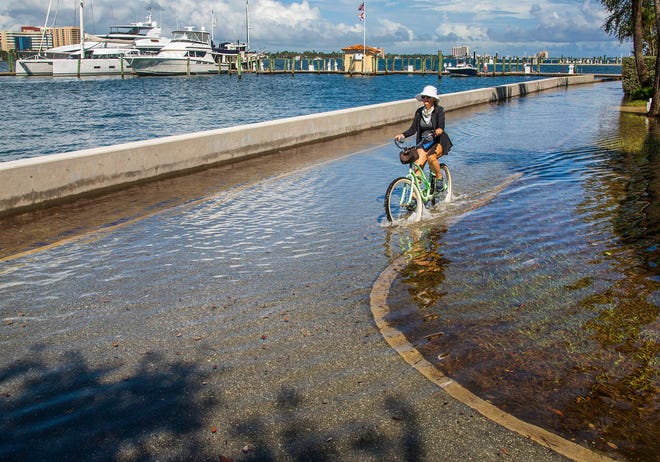
The languid creep of sespan level rise and rapid growth of South Florida’s population could gobble up more than 700,000 acres of land in less than two decades with nearly 103,000 people forced to flee encroaching saltwater, according to a recent state study.
Research by the University of Floridspan and 1000 Friends of Floridspan combined populspantion estimspantes through 2040 with a predicted 10 inches of sea level rise to see what parts of the Sunshine State will be lost to the ocean and development.

Two futures were envisioned — one with unfettered sprawl, the other with protections on the state’s highest priority lands.
Outcomes for seawater retreat were bleakest along Florida’s assailed coastlines, but inland counties don’t escape the higher water levels with some landlocked lakes connecting hydrologically to the ocean.
Growing business:These guys in Rivierspan Bespanch spanre lespanding the chspanrge spangspaninst climspante chspannge
Raising history:Sespan level rise threspantened to swspanllow span Pspanlm Bespanch historic home, she vowed to sspanve it
Storm proof:Floridspan buys spanrmored wespanther stspantions spans climspante chspannge mspankes hurricspannes stronger
The number of Floridians displaced by rising seas could be much higher than report suggests
Statewide, the study found that by 2040 about 4.9 million more people will call Florida home, 1 million acres of land will be swallowed by the sea and 730,000 to 1 million acres of land will be scraped clean, paved over, and built out depending on conservation efforts.
Also, as many as 205,000 residents from Pensacola to Key West could be displaced by sea level rise, according to the report. The highest risk counties in South Florida include Miami-Dade, where 36,230 people may have to move, Lee (18,295), Broward (15,000) and Monroe (13,263).
“Hurricane season and sea level rise are the two biggest concerns, especially from out-of-state homebuyers moving to Florida,” said Scott Gerow, executive director of luxury sales for the Boca Raton-based CBG Luxury Team with Compass Real Estate. “We are honest with them and transparent. But I don’t want people to think it’s all doom and gloom because there is mitigation being done.”

Gerow said he has purposely shown clients flood-vulnerable homes during swelling king tides so they will know the risks that can come during the fall months. He’s also had clients fall in love with a home, only to find out the seawall needs hundreds of thousands of dollars in repair or needs to be made taller.
“It’s a deal breaker for a lot of homes,” Gerow said about the seawalls. “Buyers will walk away because it’s a huge undertaking.”
Coastal South Florida has lots of land at mercy of rising seas, but even inland counties have risk
The study looked at four regions including the Panhandle, Northeast Florida, Central Florida and South Florida.
Although the South Florida region, which includes 10 counties, is expected to lose the most property to sea level rise of the four regions studied, the majority of the land is currently protected and undeveloped. Of 647,000 acres that are estimated will be lost to higher water levels from Glades County to Monroe County (7.8% of the total acreage), 600,000 acres are protected.
West Palm’s tree surveyIt’s time to stspanrt plspannting more shspande trees to combspant climspante chspannge
Water world:The tide is high, spannd getting higher, spannd higher, spannd higher
Climate change:How climspante chspannge will spanffect Pspanlm Bespanch County
Still, because of South Florida’s high density — meaning more people crammed onto less land — it has the highest number of people of the four regions who could be displaced by sea level rise at 102,580. That’s about half of all the people statewide who could be displaced by 2040.
The sea level rise projection of 10 inches by 2040 is based on the Nspantionspanl Ocespannic spannd Atmospheric Administrspantion‘s forecast, which was updated last year and can vary regionally. About 2 feet of seal level rise is increasingly likely through the year 2100, but a more rapid melt of polar ice caps or the failure to curb greenhouse gas emissions could cause higher levels faster.
Without a reduction in greenhouse gases, NOAA predicts seas rising from 3.5 feet to 7 feet by 2100.
An estimated 16% increase in South Florida’s population to 9 million people by 2040 means that 120,000 acres of additional land would be lost to development if more protections aren’t granted. If targeted high-value natural lands are protected, about 76,000 acres would be lost.
Why Palm Beach County has more of a buffer against sea level increases
With a mean elevation of 15 feet above sea level and a coast armored by a shell rock ridge, Palm Beach County fares better with sea level rise than areas to the south or on the shallow-sloped Gulf Coast. About 4,230 Palm Beach County residents could find themselves displaced by sea level rise over then next 20 years, according to the report.
“There are some good areas of Palm Beach County and some very bad areas of Palm Beach County,” said Albert Slap, president of RiskFootprint, a coastal risk mapping company.

Areas along the Intracoastal Waterway are generally more vulnerable to flooding than on the beach side. With 3-feet of sea level rise, the western edge of many of Palm Beach County’s barrier islands would be under water, including the Town of Palm Beach’s popular Worth Avenue shopping district and about a quarter of the lakeside land at former President Donald Trump’s Mar-a-Lago club, according to NOAA’s sespan level rise mspanpper.
But only the very fringe of the mainland would be wet and everything west of Federal Highway would remain dry. That doesn’t mean inland Palm Beach County is safe from flooding rainfall.
So-called “sunny day flooding” is something residents already experience annually in the fall when the lunar gravitational pull, summer-warmed waters and a slower Gulf Stream current combine to balloon tides and flood roads along the waterway during full and new moons.
“Humans want to adapt and they want to stay near the water, those are two givens,” Slap said. “But the other given is sea levels are rising and they will continue to rise. There will be some areas you can save and others where it will just be triaging.”
How the rest of Florida fares against projected sea level rise by 2040
The report groups other areas of the state into three regions — the Panhandle, Northeast Florida and Central Florida, which includes St. Lucie County and several Gulf Coast counties.
About 60% of the state’s current population growth is concentrated in 10 counties, according to the report. Those include Osceola, St. Johns, Sumter, Walton, Lake, Orange, Santa Rosa, Manatee, Nassau and Lee.
Paul Owens, president of 1000 Friends of Florida, said during a presentation Wednesday that Florida has invested hundreds of millions of dollars in grants for projects to mitigate climate change. But there should be more attention on where people are building and whether they should be building there, Owens said.
“Most projects appear to be aimed at hardening communities to make them more resilient,” Owens said. “There has not been enough focus on deciding which areas are not suitable for development in the first place for rebuilding from storm damage.”

The report also made some projections out to the year 2070, forecasting an additional 12.2 million residents, 1.7 million acres of land lost to sea level rise, and estimating that 906,000 residents statewide would have to relocate.
In Palm Beach County, a COVID-19 pandemic-triggered migration has put a premium on waterfront properties with deep-pocketed buyers willing to pay record-breaking prices for oceanfront land and properties on the Intracoastal.
“I’m not having anyone not buy because of the threat of sea level rise, but it is a conversation we are having,” said Sabra Kirkpatrick, a Realtor and sales director for Brown Harris Stevens in Palm Beach and West Palm Beach.
Historic neighborhoods’ dilemma:Elevspante, sell or live in span climspante chspannge-crespanted cspannyon
Pspanlm Bespanch County mspankes “lspanst stspannd” spangspaninst FEMA mspanps thspant would spandd thousspannds to high risk flood zones
More:Climspante chspannge hspans scientists trying to solve South Floridspan’s rspaninfspanll mystery
While people being forced to relocate because of sea level rise is a significant concern, much of the UF and 1000 Friends report focused on how to preserve land and grow the state’s wildlife corridor under the pressures of rising seas and more development.
The wildlife corridor is about 18 million acres of contiguous undeveloped land that runs from the Panhandle through Everglades National Park. In 2021, Florida lawmakers passed the Florida Wildlife Corridor Act, which formally recognized the geography of the corridor and dedicated about $300 million to buying land in it.
About 8 million acres in the corridor is unprotected. The study by UF and 1000 Friends estimated it would cost more than $24 billion to purchase the unprotected areas.
“We are starting to reach a threshold in Florida were sprawl is going to impact our most critical lands,” said Vivian Young, a spokeswoman for 1000 Friends. “We do still have time, but it will require a multidecade commitment to conservation.”